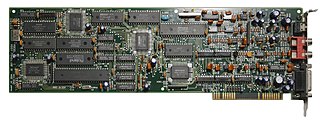
A sound card is an internal expansion card that provides input and output of audio signals to and from a computer under the control of computer programs. The term sound card is also applied to external audio interfaces used for professional audio applications.
Sierra Entertainment, Inc. was an American video game developer and publisher founded in 1979 by Ken and Roberta Williams. The company is known for pioneering the graphic adventure game genre, including the first such game, Mystery House. It is known for its graphical adventure game series King's Quest, Space Quest, Police Quest, Gabriel Knight, Leisure Suit Larry, and Quest for Glory, and as the original publisher of Valve's Half-Life series.

Ad Lib, Inc. was a Canadian manufacturer of sound cards and other computer equipment founded by Martin Prevel, a former professor of music and vice-dean of the music department at the Université Laval. The company's best known product, the AdLib Music Synthesizer Card (ALMSC), or simply the AdLib as it was called, was the first add-on sound card for IBM compatibles to achieve widespread acceptance, becoming the first de facto standard for audio reproduction.

Sound Blaster is a family of sound cards designed by Singaporean technology company Creative Technology. Sound Blaster is a brand of sound cards and audio peripherals developed by Creative Technology, a Singapore-based company. The first Sound Blaster card was introduced in 1989, and since then, the Sound Blaster brand has become synonymous with high-quality computer audio.
Mark Seibert is an American musician, composer, and producer best known for his work on various video games from Sierra Entertainment.

Roberta Lynn Williams is an American video game designer and writer, who co-founded Sierra On-Line with her husband, game developer Ken Williams. In 1980, her first game, Mystery House, became a modest commercial success; it is credited as the first graphic adventure game. She is also known for creating and maintaining the King's Quest series, as well as designing the full motion video game Phantasmagoria in 1995.

The MPU-401, where MPU stands for MIDI Processing Unit, is an important but now obsolete interface for connecting MIDI-equipped electronic music hardware to personal computers. It was designed by Roland Corporation, which also co-authored the MIDI standard.

The Roland MT-32 Multi-Timbre Sound Module is a MIDI synthesizer module first released in 1987 by Roland Corporation. It was originally marketed to amateur musicians as a budget external synthesizer with an original list price of $695. However, it became more famous along with its compatible modules as an early de facto standard in computer music. Since it was made prior to the release of the General MIDI standard, it uses its own proprietary format for MIDI file playback.

Softporn Adventure is a comedic, adult-oriented text adventure game produced for the Apple II in 1981. The game was created by Charles Benton and released by On-Line Systems, later renamed Sierra On-Line. Years later, Softporn Adventure was remade and expanded as Leisure Suit Larry series of adult-oriented video games, and the first entry in that series, 1987's Leisure Suit Larry in the Land of the Lounge Lizards, was a nearly direct graphical adaptation of Softporn Adventure. Another graphical version was released as Las Vegas for various Japanese computers in 1986 by Starcraft.

King's Quest IV: The Perils of Rosella is a graphic adventure game developed and released by Sierra On-Line for the MS-DOS, Amiga, Apple II, Apple IIGS, and Atari ST computers in 1988. The player takes on the role of Princess Rosella, daughter of King Graham of Daventry and the twin sister of Gwydion/Alexander, who must save her father and a good fairy and destroy an evil witch. Critically acclaimed, it was one of the first PC games to support a sound card.
Hoyle's Official Book of Games is a series of games developed and published by Sierra On-Line. Volume 1, released in 1989, featured multi-player card games. Volume 2, released in 1990, featured 28 varieties of Solitaire. Volume 3, released in 1991, featured board games. Volume 4, was a remake of Volume 1, with two additional games. Sierra continued to publish more games to the series up to its demise. Encore Software has continued publishing entries to the series since then. According to Hoyle 1, it was essentially a spiritual sequel to Sierra's Hi-Res Cribbage (1981).

Leisure Suit Larry Goes Looking for Love (in Several Wrong Places) is the second game in the Leisure Suit Larry series of graphical adventure games, designed by Al Lowe and published by Sierra On-Line in 1988. Like its predecessor, Leisure Suit Larry in the Land of the Lounge Lizards, it was developed for multiple platforms, including MS-DOS, Atari ST and Amiga. It utilizes Sierra's Creative Interpreter (SCI0) engine, featuring 16-color EGA graphics and a mouse-based interface for movement. The story continues the exploits of Larry Laffer, who becomes stranded on a tropical island during an ill-fated vacation.

Leisure Suit Larry III: Passionate Patti in Pursuit of the Pulsating Pectorals is a graphical adventure games designed by Al Lowe and published by Sierra On-Line for DOS, Atari ST and Amiga in 1989 as the third entry in their Leisure Suit Larry series. The plot first follows series protagonist Larry Laffer, fresh from an abrupt divorce, as he combs through a tropical resort looking for love. After he meets the latest woman of his dreams, Passionate Patti, and leaves her to enter the wilderness, the player takes control of Patti to search for him.

Leisure Suit Larry in the Land of the Lounge Lizards is a graphic adventure game, developed by Sierra On-Line, and published in 1987. It was developed for the PC, DOS, and the Apple II and later ported to other platforms, such as the Amiga, Atari ST, Apple IIGS, Macintosh, and Tandy Color Computer 3. It utilizes the Adventure Game Interpreter (AGI) engine. In 1991, Sierra released a remake titled Leisure Suit Larry 1: In the Land of the Lounge Lizards for PC DOS, Apple Macintosh, and Amiga. This version used the Sierra's Creative Interpreter (SCI) engine, featuring 256 colors and a point-and-click, icon-driven user interface.

The Roland LAPC-I is a sound card for IBM PC compatible computers produced by Roland Corporation. It basically consists of a MT-32-compatible Roland CM-32L and a MPU-401 unit, integrated onto a single full-length 8-bit ISA card. In addition to normal Roland dealers aimed at musicians, it was distributed in the United States by Sierra On-Line in 1989 for use with the company's games. The MSRP of the card was around US$425.
The Roland SC-55 is a GS MIDI sound module released in 1991 by Roland. The SC-55 was the first sound module to incorporate the new General MIDI standard. It was the first in the Roland Sound Canvas series.

Space Quest III: The Pirates of Pestulon is a 1989 graphic adventure game by Sierra On-Line, and the third game in the Space Quest series.
Princess Rosella is widely considered to be the first ever female protagonist in a graphic adventure game or one of the very first at least. She appeared as the main and titular protagonist of the 1988 adventure game, King's Quest IV: The Perils of Rosella, and co-protagonist in a later sequel in the franchise, 1994's King's Quest VII: The Princeless Bride, in addition to appearing in other games and books in the series as well as cameoing in other non-franchise games. Created by Roberta Williams, the character was also the first female character to feature in Williams's King's Quest franchise.
Linear arithmetic synthesis, or LAsynthesis, is a means of sound synthesis invented by the Roland Corporation when they released their D-50 synthesizer in 1987.

Police Quest: In Pursuit of the Death Angel is a 1987 police procedural adventure video game developed and published by Jim Walls and Sierra On-Line. Police Quest follows police officer Sonny Bonds as he investigates a drug cartel in the town of Lytton, California.














